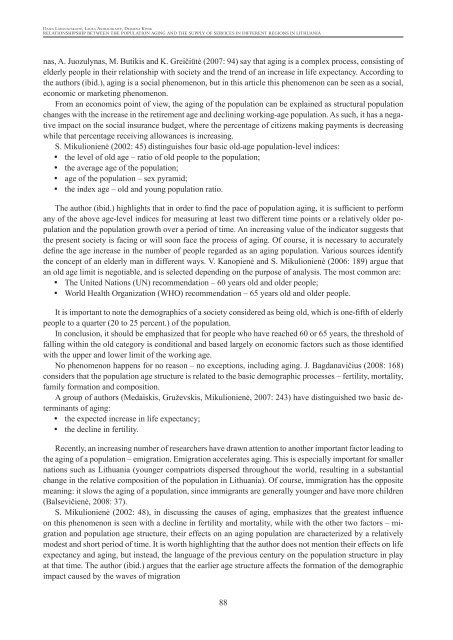regional formation and development studies - KlaipÄdos universitetas
regional formation and development studies - KlaipÄdos universitetas
regional formation and development studies - KlaipÄdos universitetas
Create successful ePaper yourself
Turn your PDF publications into a flip-book with our unique Google optimized e-Paper software.
Daiva Labanauskaitė, Laura Astrauskaitė, Deimena Kiyak<br />
RELATIONSHIPSHIP BETWEEN THE POPULATION AGING AND THE SUPPLY OF SERVICES IN DIFFERENT REGIONS IN LITHUANIA<br />
nas, A. Juozulynas, M. Butikis <strong>and</strong> K. Greičiūtė (2007: 94) say that aging is a complex process, consisting of<br />
elderly people in their relationship with society <strong>and</strong> the trend of an increase in life expectancy. According to<br />
the authors (ibid.), aging is a social phenomenon, but in this article this phenomenon can be seen as a social,<br />
economic or marketing phenomenon.<br />
From an economics point of view, the aging of the population can be explained as structural population<br />
changes with the increase in the retirement age <strong>and</strong> declining working-age population. As such, it has a negative<br />
impact on the social insurance budget, where the percentage of citizens making payments is decreasing<br />
while that percentage receiving allowances is increasing.<br />
S. Mikulionienė (2002: 45) distinguishes four basic old-age population-level indices:<br />
• y the level of old age – ratio of old people to the population;<br />
• y the average age of the population;<br />
• y age of the population – sex pyramid;<br />
• y the index age – old <strong>and</strong> young population ratio.<br />
The author (ibid.) highlights that in order to find the pace of population aging, it is sufficient to perform<br />
any of the above age-level indices for measuring at least two different time points or a relatively older population<br />
<strong>and</strong> the population growth over a period of time. An increasing value of the indicator suggests that<br />
the present society is facing or will soon face the process of aging. Of course, it is necessary to accurately<br />
define the age increase in the number of people regarded as an aging population. Various sources identify<br />
the concept of an elderly man in different ways. V. Kanopienė <strong>and</strong> S. Mikulionienė (2006: 189) argue that<br />
an old age limit is negotiable, <strong>and</strong> is selected depending on the purpose of analysis. The most common are:<br />
• y The United Nations (UN) recommendation – 60 years old <strong>and</strong> older people;<br />
• y World Health Organization (WHO) recommendation – 65 years old <strong>and</strong> older people.<br />
It is important to note the demographics of a society considered as being old, which is one-fifth of elderly<br />
people to a quarter (20 to 25 percent.) of the population.<br />
In conclusion, it should be emphasized that for people who have reached 60 or 65 years, the threshold of<br />
falling within the old category is conditional <strong>and</strong> based largely on economic factors such as those identified<br />
with the upper <strong>and</strong> lower limit of the working age.<br />
No phenomenon happens for no reason – no exceptions, including aging. J. Bagdanavičius (2008: 168)<br />
considers that the population age structure is related to the basic demographic processes – fertility, mortality,<br />
family <strong>formation</strong> <strong>and</strong> composition.<br />
A group of authors (Medaiskis, Gruževskis, Mikulionienė, 2007: 243) have distinguished two basic determinants<br />
of aging:<br />
• y the expected increase in life expectancy;<br />
• y the decline in fertility.<br />
Recently, an increasing number of researchers have drawn attention to another important factor leading to<br />
the aging of a population – emigration. Emigration accelerates aging. This is especially important for smaller<br />
nations such as Lithuania (younger compatriots dispersed throughout the world, resulting in a substantial<br />
change in the relative composition of the population in Lithuania). Of course, immigration has the opposite<br />
meaning: it slows the aging of a population, since immigrants are generally younger <strong>and</strong> have more children<br />
(Balsevičienė, 2008: 37).<br />
S. Mikulionienė (2002: 48), in discussing the causes of aging, emphasizes that the greatest influence<br />
on this phenomenon is seen with a decline in fertility <strong>and</strong> mortality, while with the other two factors – migration<br />
<strong>and</strong> population age structure, their effects on an aging population are characterized by a relatively<br />
modest <strong>and</strong> short period of time. It is worth highlighting that the author does not mention their effects on life<br />
expectancy <strong>and</strong> aging, but instead, the language of the previous century on the population structure in play<br />
at that time. The author (ibid.) argues that the earlier age structure affects the <strong>formation</strong> of the demographic<br />
impact caused by the waves of migration<br />
88

















